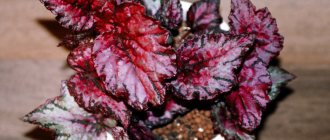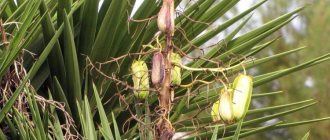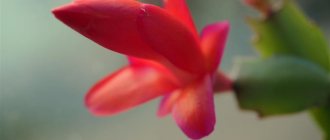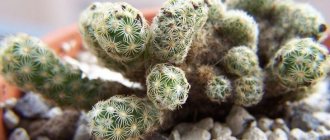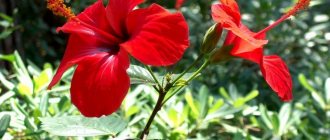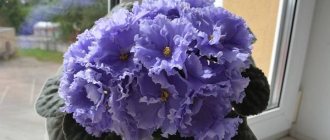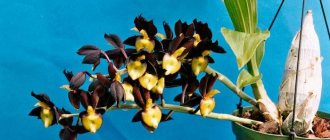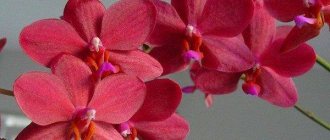Botanical description and history
Beautiful Sinningia is known to amateur gardeners under the name Gloxinia . This is a tropical tuberous plant with bell-shaped, velvety, large, brightly colored flowers. Gloxinia has a straight stem, fleecy leaves, and solitary flowers.
Attention : The shades of gloxinia are very diverse. Flowers can be monochromatic, combined with white, have spots, streaks, borders, and shimmer in the bright sun. The flower has a ring nectary and four stamens.
In nature, this plant can be found in Brazil, America, and Mexico. It grows on rocks near the river, in tennis forest thickets. Gloxinia is grown in greenhouses and at home.
The flower belongs to the Gesneriaceae family. It was first found in Brazilian forests in 1785. It is South and Central America that is considered the birthplace of this plant. Boston University scientist V. Sinning has developed many hybrids of this plant, including the very popular Gloxinia rosea. In honor of this breeder, gloxinia received its second name - Sinningia .
General characteristics
Gloxinia is a perennial herbaceous or subshrub plant of the Gesneriaceae genus . In nature, it forms colonies along river banks, on rocky ledges, and in damp, shady tropical forests of South and North America.
History of origin
Gloxinia was first described in the 18th century by the Alsatian naturalist Benjamin Peter Gloxinia, who discovered the flower in Brazil. The naturalist called it by his own name, adding the epithet “speckled.”
Botanical description
The most important generic characteristics of gloxinia:
- Most indoor gloxinias are tuberous plants. The tuber is large (up to 40 cm in diameter), round, scaly.
- The stem is shortened, glabrous or slightly pubescent.
- The leaves are thick, fleshy, juicy, intense light, dark green, silver in color, with a velvety surface.
- The lower part of the leaf is green, reddish or purple. The arrangement is opposite or trifoliate. The leaf blade is oval or elongated. The width varies from 1 cm to 20 cm. The petiole is thickened and dense. The height of the rosette is from 2.5 cm to 30 cm.
- Peduncles are long from 1 to 15 cm. Single flowers have the shape of a glass, funnel, bell, gramophone, goblet, but all have a wide throat and an elongated tube, divided by a five-petal tubular corolla with five stamens, four anthers and a long pistil.
- The flowers are large (8-12 cm in diameter), simple, semi-double and double, multi-petaled with a simple, corrugated or wavy edge.
- From 1 to 20 flowers can bloom on one plant. The color range is varied, excluding yellow and brown. The flowering period is from early spring to late autumn.
- The fruit is a cone-shaped capsule with many brown small seeds.
Varieties and their photos
Fairy tale
Gloxinia called pink fairy tale blooms with gorgeous large velvet pink flowers. The center of the petals is crimson, the neck is light, strewn with dark specks.
Extravaganza
A variety of gloxinia called extravaganza also has large velvety flowers with a bright pink border and specks along the edges of the petals. The peduncles of Gloxinia extravaganza are short, pink-coral in color. As the buds bloom, they increase in size.
Dream
Gloxinia variety pink dream is a miniature flower with bright, elegant pink flowers . This flower has an elongated tube and a light-colored neck. The Pink Dream variety has a long flowering period.
Gloxinia varieties
Since enthusiasts around the world have been breeding these wonderful flowers for more than 200 years, a great variety of varieties have been bred. Collectors can find real curiosities, but there are much fewer popular varieties - you can hardly find 2 - 3 dozen on general sale.
Blanche de Meru. A compact cultivar with flowers of original color: the tubular base of the corolla is white, and the edges of the petals are dark pink. The diameter of the flower is about 8 cm. One adult plant can have up to 20 flowers at the same time.
Violacea . Its flowers are a very rich purple color with a white base and corrugated petals.
Gloxinia variety Violacea. Photo: pixabay.com
Hollywood (Hollywood). An incredible variety with dark purple, almost black flowers with wavy edges of the petals.
Defiance . A stunning variety with rich red flowers and wavy petal edges.
Kaiser Wilhelm. This variety has very spectacular flowers of deep purple color with a white border along the edge of the petal.
Kaiser Friedrich . It is similar to Kaiser Wilhelm, it also has a white border along the edges of the petals, but the corollas themselves are painted dark red.
Gloxinia variety Kaiser Friedrich. Photo: pixabay.com
Corina . A charming variety with bright red petals and a white base.
Krispa Meteor . A variety with bright red flowers and a thin white edge around the edges of the petals. In addition, the edges of the petals are also corrugated.
Mont Blanc . A variety with pure white corollas.
Prince Albert. It has very elegant, dark purple flowers with a white base with small purple speckles scattered throughout.
Roi de Rouges. A spectacular variety with scarlet flowers. The base of the corolla is white, speckled with red.
Tiger Blue. The name of this variety translates as blue tiger, although, of course, it is more likely to be a leopard. The base of the flowers is pure white, then numerous specks of purple are mixed into it, and the edges of the petals are pure purple.
Tiger Red. Almost an exact copy of the Tiger Blue variety, but, as the name suggests, the spots and tips of its petals are red.
Etoile de Feu. A variety with burgundy-red flowers, the base of which is slightly white, and the edges of the petals have a thin white border.
Description of appearance and features
Pink Gloxinia is a tuberous plant with beautiful flowers. The thickened stems of gloxinia grow up to 10 cm in height; 4-6 pairs of leaves with opposite arrangement grow on the plant.
The leaves are oval, wide, heart-shaped at the base, velvety, 15 to 20 cm long. The veins of the upper part of the leaf are silvery, the lower part of the leaf has a reddish tint. The flowers of pink gloxinia are bell-shaped, velvety, on long peduncles .
Important : Growing gloxinia is not difficult, it is not picky about the soil, it reproduces easily and blooms profusely.
Gloxinia species
Nature gave the world 25 different species of gloxinia, but only two were used to create hybrids. Types of hybrid gloxinia differ in the size of the diameter (in cm) of the plant and are called:
- Standard – more than 25.
- Compact – 12-25.
- Miniature – 5-12.
- Microminiature - less than 5.
Flowers can be:
- tubular and funnel-like, cube-shaped;
- with many petals and in one row;
- with and without fringe;
- terry and semi-double;
- down and looking up.
The color palette is rich, depending on the variety they can be one-color or two-color, multi-color (this applies to calico and tiger gloxinias). Peduncles from 2 to 25 cm.
In recent years, Svyatoslav Sinetsky has been producing hybrids. Thanks to him, new varieties of gloxinia appeared on the windowsills of lovers of colorful bells. You can purchase seeds, tubers, as well as a varietal mixture of flowers, including gloxinia, in the Garden World online store.
Where and how to plant it: rules and tips, instructions
When purchasing gloxinia tubers, you should pay attention to their size and appearance. They should be hard, 3-4 cm in size, without traces of mold or rot. In the upper part of the gloxinia tuber there is a depression where a bud is located, which looks like a tubercle.
Gloxinia is planted at a time when the tubers wake up after winter dormancy . This can be seen by the sprouts that appear. Most often this happens in February or March. You should not wait until the sprout grows large; you should plant a slightly sprouted tuber.
If the tuber is slightly damaged, then the damaged area should be cut out and sprinkled with charcoal, and the cut should be treated with a mixture of fungicide and root. After this procedure, it should be dried.
Rules for planting gloxinia:
Place a layer of drainage up to 2 cm high at the bottom of the pot. This can be expanded clay or polystyrene foam. Sprinkle soil on top without compacting it.- Make a hole in the center of the pot, place the tuber in it and sprinkle 2/3 of it with soil. The soil needs to be watered, but so that water does not get on the sprouts and in the center of the tuber, otherwise this may lead to rotting of the plant.
- To create the necessary microclimate, the pot is covered with polyethylene and placed in a warm, well-lit place - this helps create a greenhouse effect.
- Every day the pot is opened for 10-15 minutes to ventilate the plant. After the first leaves appear, the flower is covered only at night, and after a few days the polyethylene is removed altogether.
- As the stem grows, the tuber should be sprinkled with 1-2 cm of soil so that it remains in the ground and does not deteriorate.
- At first, you should water the plant little by little and carefully so that the tuber does not rot.
Lighting and location
Gloxinia loves good and even lighting because it has the peculiarity of reaching for light. However, direct sunlight can cause burns on the leaves of the plant, so the light should be diffused. In spring, gloxinia can stand on the sunny side, but when hot weather sets in, the plant should be shaded a little.
The best place for pink gloxinia is a rack and artificial lighting. In such conditions, gloxinia are protected from drafts and receive the required amount of light. The rosettes grow neat and the leaves are juicy.
Soil requirements
Indoor gloxinia is not very picky about the composition of the soil. The substrate for pink gloxinia tubers should be light, loose, nutritious, it should absorb moisture well and be permeable to air. Peat-based soil is suitable for such purposes.
A substrate that is too dense can retain moisture, and the flower will rot and die . For gloxinia, soil for flowering plants is suitable, to which you should add a couple of handfuls of sand and two tablespoons of vermiculite per liter of soil mixture. You can also prepare the soil yourself. To do this, mix leaf soil, sand and peat in a ratio of 2/2/1.
Advice : Before planting tubers in the soil mixture, it must be calcined in the oven or sprayed with the “Maxim” preparation in a proportion of 2 ml per liter of water and allowed to dry.
The nuances of growing Sinningia
If you have an indoor Sinningia flower, you should learn how to care for it and what conditions to create for the normal development of this plant.
Gloxinia needs bright, diffused light; windows with south-eastern exposure are preferred. In the middle of the day, shading from the sun is necessary. With insufficient lighting, the shoots of the plant become elongated, and the color of the greenery and buds becomes less bright and saturated.
Content temperature -18-20 °C. During the dormant period, pots with tubers are stored at a temperature of 10-12 ° C for 3-4 months.
In summer, the plant requires high humidity; you can place it on a tray with wet gravel. It is not recommended to spray Sinningia, as drops of water falling on the leaves have a bad effect on the development of the flower. At the same time, in places where the greenery comes into contact with the liquid, spots appear, a kind of burns, which reduce the decorativeness of the plant. To maintain the required humidity, you can also spray the air around the pot.
If you know all the intricacies of growing Sinningia and how to care for it, then it will definitely thank you with beautiful bright flowers. Another rule in growing this plant is to protect it from excessive heat, which is detrimental to it. A significant increase in temperature leads to wrinkling and active drying of leaves. On especially hot days, when the air warms up above 20 °C, provide the flower with optimal air humidity and shade it. This will help to survive unfavorable conditions for the development of syningia.
It is better to prepare a substrate for it from leaf and peat soil, with the addition of sand (1: 1: 0.5); it should be slightly acidic.
Despite the fact that Sinningia does not like drafts and does not grow well on balconies, the room where it lives should be ventilated. A sharp change in ambient temperature is also considered dangerous for the flower.
Sinningia does not require complex care, but when maintaining it, if you want to see abundant and beautiful flowering, you should still pay attention to some nuances of cultivation.
Namely:
- Timely watering.
- Feeding.
- Features of transplantation.
In summer, provide abundant watering, in spring and autumn - moderate. When caring for Sinningia at home, you should not flood it, and you should not allow water to get on the leaves. If the tubers of the plant are overly moistened, they become soft and quickly begin to rot, which leads to the death of the flower. Therefore, it is better to water the synningia frequently and with a small amount of water at room temperature. Pour the liquid not into the earthen lump, but into the pan in which the pot is installed. The amount of watering should be reduced after the flowering period ends. In winter, when the flower goes into a dormant period, moisture is reduced to a minimum, and its purpose is to prevent the plant tuber from drying out.
When caring for the Sinningia flower during the period of growth and flowering, it requires feeding with complete mineral fertilizer. You can also use a mixture purchased in specialized stores for flowering plants. It should be diluted according to the instructions provided and added to the water for irrigation in the pan. When Sinningia fades, feeding stops.
In the spring, the tubers are freed from the old soil, transplanted into a new substrate (eyes up) and placed in a warm, bright place. The pot for the plant is chosen to be wide and small. After Sinningia blooms, the dried stems and leaves are removed, leaving a small stump.
For information on the peculiarities of growing Sinningia and caring for it at home, watch the video:
How to properly care?
Pink gloxinia is a non-capricious plant and very grateful . In order for her to feel comfortable, you need to follow simple rules:
Water with warm, settled water.- In order not to over-water the plant and not get water on the leaves and flowers, it is advisable to water it in a tray.
- To provide gloxinia with the necessary air humidity, the flower pot can be placed in a special tray filled with wet expanded clay.
- During the period of active growth (April-September), the plant must be fed with complex liquid fertilizers.
- When flowering ends, gloxinia is prepared for a period of rest. To do this, cut off the above-ground part of the plant, leaving a stump 2 cm high, and put the pot in a dark, cool place.
- At the end of February, the tubers are transplanted into new soil, having cleared of the old soil, cutting off their rotten parts and disinfecting the cuts.
Under favorable conditions, gloxinia can throw out up to twenty buds at the same time.
Gloxinia pests
Spider mite. This is the scourge of many indoor plants and gloxinia is no exception. First, small white dots appear on the leaves, and if the infection is severe, cobwebs appear.
You can recover from mites if you treat the plants with Akarin, Bicol or Fitoverm (4) twice with an interval of 2 weeks.
Aphid. It usually settles on leaves and feeds on their juice. The castings gradually become deformed, and a secondary infection, late blight, may appear on them.
Gloxinia can be treated against aphids with Actellik and Fitoverm (4).
Mealybug. This pest lives on leaves and shoots. It can be detected by waxy discharge, which is somewhat similar to cotton wool.
The drugs Aktara and Actellik (4) help against this pest - you need to do 2 treatments with an interval of 2 weeks.
Common diseases and pests
If not properly cared for, gloxinia may become sick or be affected by certain pests.
- Watering with cold water may cause brown spots to appear on the leaves.
- If there is an overdose of fertilizers or dry or too humid air, the leaves may turn yellow.
- A sign of the presence of powdery mildew or gray rot can be a gray coating on flowers and leaves.
To save the plant, you should remove damaged leaves and flowers, moderate watering, and treat the flower with a fungicide.
If gloxinia does not bloom, then add lighting to it and increase fertilizing with a minimum amount of nitrogen . Elongated pale green leaves can also indicate a lack of light.
Among the parasites that affect Gloxinia rosea are scale insects, whiteflies, spider mites, and mealybugs.
Gloxinia dormant period. When to remove gloxinia from dormancy: ending hibernation successfully
“Love at first sight” is the name given to gloxinia flowers according to the first European “language of flowers”, created by King Charles II in the 18th century. It's hard not to fall in love with these exquisite, velvety flowers. But they are distinguished not only by their unpretentious beauty, because, along with other colors, they effectively purify the air in the room.
To enjoy the splendor of flowers, it is important to know when to remove gloxinia from dormancy and what to do if the awakening process does not go as expected.
When to remove gloxinia from dormancy
Gloxinia tubers have a certain period of hibernation, which lasts 4-5 months. The first time they are taken out is in the middle of winter for a thorough examination and selection of healthy specimens. It may happen that they begin to wake up earlier - this is due to improperly created storage conditions, high humidity, or a room that is too warm and bright.
Conditions for storing flowers during the dormant period:
- Cool place with a temperature of 15-17°.
- A dark place where the sun's rays do not penetrate.
- Humidity no more than 30%.
- Spraying the soil or tubers once every 2-3 weeks.
If properly stored, you can start checking for the appearance of sprouts in December.
According to the growing season, the optimal time for gloxinia to wake up after hibernation is the month of March, when daylight hours increase and the air temperature rises.
The tubers are taken out, laid out on the windowsill, and sprinkled with water. Within 7 days, the first roots and sprouts appear, after which they are planted in pots. You can help the plant awaken using vermoculite or hydroballs: they are poured into a container in a thin layer, and the tuber is placed on top with the convex side. Young plants of the first and second years of life may not go into hibernation, so during the expected dormant period they need more attention. Watering is moderate, fertilizing is done every 2-3 weeks.
If the plant was stored in the ground, then it is better to replant it by transshipment, after first examining it for the presence of daughter nodules. The babies are separated and planted under glass for rearing with frequent feeding.
The photo shows gloxinia in the spring after a dormant period:
What to do if gloxinia wakes up earlier: in January or February
If the tubers began to germinate ahead of schedule, in January or February, then gardeners use 2 methods:
- If the sprouts are no more than 1 cm, then the nodules are moved to a cooler and darker place. This method will slow down the growth process for 1-1.5 weeks, after which you will have to pull them out and carry out the awakening process.
- If the sprouts are more than 1 cm, then mini-greenhouses are prepared. A small layer of light, nutritious, moist soil is laid on the bottom and gloxinia is planted. Cover the top with glass or transparent plastic film. The container is placed in a warm, bright place so that roots form on the nodules and the sprouts begin to grow intensively. After 2-3 weeks, it will be possible to plant the plant in a separate container with light, breathable soil made from leafy soil, peat and sand. The soil acidity level is not more than 6.5.
In the first case, measures are taken to transfer them to another room if the plants wake up before mid-January. And if they woke up by the end of January or in February, then there is no need to delay the growing season.
Some gardeners, when waking up early, pick off the sprouts and place the gloxinia in a dark, cool place to continue sleeping.
What to do if the flower does not wake up
The reason for prolonged sleep may be improper storage conditions: drying out of the soil or not spraying the nodules that are in boxes without soil, too wet storage space. If the flower has not woken up until the end of April or beginning of May, it is worth taking measures to awaken them.
To awaken the plant, take it to a warm room, place it in a bright place and gradually increase the amount of watering. If the tuber was not in the ground, then a mini-greenhouse is made for it, only the tuber part is buried in the soil mixture for root germination. If there is no soil, then you can put a small layer of sawdust in a pot, moisten it and put a tuber on top, which will need to be sprayed daily.
Eternal peace
Flower growers rarely encounter a problem when gloxinia does not wake up at all. If this does happen, the reasons may be the following:
- The tuber is old, completely rotted, or it was put into hibernation too young.
- Unripe plants were put to rest.
- The planting material was not purchased from reputable sellers and was of poor quality.
- Infection with a viral disease. The tuber must be inspected and if there is rot, part of it must be cut off. Rub the cut area with activated carbon, wood ash or garden varnish.
- Drying out, during the winter the flower was never watered or sprayed. If the tuber is still hard, then it can be saved by soaking it for a day in warm water with a growth stimulator. And after a day, organize a greenhouse in which it will grow.
Long sleep for gloxinia is the key to abundant flowering, during which time the tubers gain strength and new growth buds are formed.
Features of reproduction
Pink gloxinia propagates in several ways: tubers, leaf cuttings and seeds . Let's look at them.
Tubers
For division, a very overgrown tuber is taken. Using a sharp knife, it is cut into pieces so that each has a sprout. The cut area is sprinkled with activated carbon.
Parts of the tuber are planted in separate pots with moist soil . For the first 2-3 days after planting, the substrate is not moistened.
Watch a video about dividing a gloxinia tuber:
Leaf cuttings
When propagating by leaf cuttings, a young healthy leaf with a part of the cutting 1 cm long is cut off from a flowering plant. The cutting is rooted in a mixture of sand and peat in a ratio of 4/0.5. Cover the cuttings with a glass jar and maintain the temperature at 22-24 degrees.
Young nodules appear after 20 days . After this, the cuttings can be planted in separate containers.
Watch a video about propagating gloxinia using leaves:
Seeds
Gloxinia should be sown in November-February in wide, low containers filled with a substrate made from equal parts of peat soil, leaf soil and sand. Sow the seeds sparsely and shallowly, lightly sprinkled with soil.
The container is placed in a bright place where the temperature is maintained at 25 degrees. Periodically, the soil should be sprayed with warm water. Gloxinia begins to sprout after 12-14 days.
Plants are planted when two leaves form on them , at a distance of 2 cm from one another. Plants are planted in different pots when their leaves begin to touch each other.
Watch a video about propagating gloxinia by seeds:
Gloxinia rosea is undoubtedly a beautiful flower that can decorate any home. However, there are other, no less delightful species and varieties of gloxinia, you can learn more about them from the following publications:
- How to properly breed hybrid gloxinia at home?
- Terry gloxinia Yesenia: description of the flower and the care it needs.
- How to care for and propagate Gloxinia Rosalinda at home?
- White terry gloxinia is a beautiful and delicate flower in your home.
- Description of Gloxinia Brokada, tips for planting and propagating the flower.
- How to grow decorative gloxinia Sonata at home?
- Detailed description and characteristics of gloxinia varieties Kaiser Wilhelm and Friedrich.
- Description and features of growing varieties Krasnoyar'e and Red Riding Hood.
- One of the most beautiful varieties is Gloxinia Shagane.
Home care
Sinningia is easy to care for at home and unpretentious. Thanks to this, growing at home is accessible even to novice gardeners.
Lighting
Sinningia loves light, but is afraid of the scorching sun. East or west windows, or slightly shaded south windows are suitable for its placement. Particularly bright lighting is usually required for seedlings or saplings that are just forming a root system.
Temperature
In summer, the heat-loving Sinningia will be satisfied with a temperature of about 22-25 degrees. But after the dormant period has begun, the pot with the tuber must be moved to a dark and cool room, where the temperature remains no more than 12-15 degrees. Only such conditions will allow the flower to fully rest and gain strength before the new season.
Humidity level
The Sinningia flower prefers high humidity, but it should not be sprayed in the usual way. Moisture on the fluffy leaves and buds of the plant can leave stains on them. Instead of a sprayer, it is better to use open containers with water or place the flower on a tray with wet pebbles. You can keep the pot close to the aquarium.
Selection of capacity
The size of the pot for syningia directly depends on the size of its root system. Small tubers can be planted in small pots about 10 cm in diameter. Larger ones will also need an appropriate pot. But you shouldn’t immediately plant a small plant in a spacious container. In this case, all the strength of the tuber will be spent on the formation of leaves, and not on flowering.
Regularity of watering
Sinningia is a moisture-loving crop. It needs regular watering. However, it is not tolerant of moisture stagnation. Excessive dampness is detrimental to beauty tubers.
The key to successfully growing syningia at home is well-drained soil.
The frequency of watering is determined based on the degree of drying of the top layer of the earthen clod. To do this, you just need to note for yourself the day when the soil dries out, and, after waiting two days, water the plant again.
The fact that the soil has been saturated with moisture for a long time can be easily determined by the appearance of the bush. Its petioles and peduncles turn black, and the leaves become soft.
To water the crop, use only water that has settled for 24 hours at room temperature. Watering is carried out at the root of the plant, being careful not to wet the leaves and flower stalks.
In the autumn, when flowering ends and the dormant period begins, the number of waterings is reduced to a couple of times a month. By November, the plant almost completely fades. In winter, containers with roots are watered only once a month, avoiding waterlogging of the soil composition.
If the tubers of the plant are placed in sawdust or peat for the dormant period, there is no need for watering at all.
Feeding
Sinningia needs to be fertilized only during active growth - from April to October. For fertilizing, liquid formulations containing more potassium and phosphorus and less nitrogen should be used. They are applied once every 15-20 days.
Transfer
Small synningias grown from seeds or leaf cuttings will need several replantings per year. This is due to the active rate of their growth and tuber formation. Formed plants are moved to fresh soil less often - every spring.
When replanting, it is important not to bury the tuber completely in the soil. It should rise above ground level by at least one third.
Trimming
The shape of the synningia bush does not require pruning. Periodically, plants are simply cleaned of wilted leaves or flowers. In the fall, when the green part of the bush dries out, it is cut off, leaving only a small stump no larger than 2 cm in size.
Fertilizers
Fertilizing should be done throughout the growing season, as well as during the flowering of gloxinia. After flowering and during the dormant period, fertilizers are not applied. It is recommended to use mineral fertilizers.
Experienced gardeners advise using the following fertilizer scheme:
- Growing season – fertilize with nitrate fertilizer once every 10 days.
- Formation of buds - once every 10 days with potassium phosphate and superphosphate.
- Flowering period – 1 time in 10 days with potassium nitrate.
Do not overuse nitrogen. This can provoke active leaf growth and the development of small flowers.
Bloom
Adult domestic sinningia begins to bloom in late spring and ends closer to autumn. During this period, long, most often slightly drooping peduncles form on the bush. They bear large single flowers with petals of a wide variety of colors. The widest range of shades is presented in hybrid forms. It includes white, yellow, pink, red, lilac and some other colors.
Some similar plants sold in stores are hybrids, bred only for the sake of lush seasonal flowering. Such bushes do not survive the dormant period, but there are also many hybrid syningias that can adapt to home conditions and resume their growth every year, as expected. Many hybrid varieties are grouped according to flower shape or color.
Features of flower care in summer
With the onset of summer, the flower begins its growing season. At this time, the plant needs good watering and fertilizing the soil. In summer, the flower should be kept in a room where the temperature is between 19-22° and the air humidity is not lower than 80%.
To maintain the required air humidity near the plant, you need to place a tray with wet pebbles or expanded clay. There is no need to spray the flower.
Life cycle, dormant period
The life cycle of Gloxinia begins in the spring, when the seeds are sown in the soil or when the plant breaks dormancy. Seed material is sown in soil, which consists of turf and leaf soil, peat and sand. Tubers are planted in the same soil mixture, without deepening them too much.
Until the tubers take root or the seeds sprout, the soil is watered moderately.
With the onset of the dormant period (October), the leaves and shoots of the flower begin to turn yellow. At this time, the plant needs to create special conditions.
There are 2 options for storing a flower during the dormant period:
- After the leaves die off, the plant is rarely watered and fertilizing is not carried out. Completely dried leaves need to be cut off, and the pot with the tuber should be placed in a dark place where the air temperature is from 10 to 13°. It is recommended to lay the pot on its side. After the onset of spring (March), the tubers are dug up and transplanted into new soil. The flower moves to an even whiter, darker room for 3–5 days. After this, Sinningia is cared for as usual at home.
- After the leaves and shoots are completely dry, they need to be carefully cut off and the tuber dug up. Rinse the roots and tuber well under cool running water, and then remove the dried and rotten roots. After washing, the tuber is not dried, but is immediately placed in a tray filled with wet perlite. The pallet should be placed in a dark, cool room where the temperature is no higher than 13°. After approximately 80-90 days, young shoots will appear on the tuber. This means that it is rested and ready for the growing season. In this situation, the tuber is planted in the soil mixture.
The plant is gradually brought out of the dormant period: the abundance and frequency of watering increases, fertilizing begins, and the temperature in the room gradually rises.



